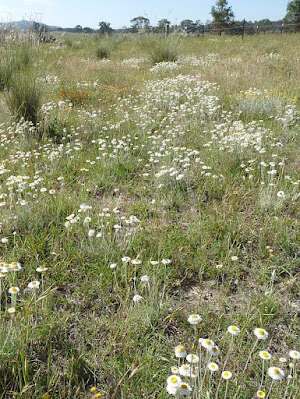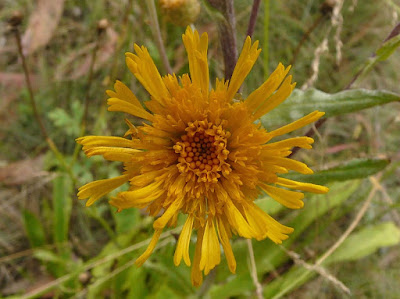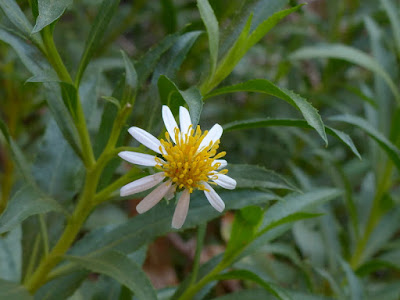Daisies seem to rule, I often think. There may be in excess of 30,000 species of them, though 24,000 is a more often cited tally. The mighty Flora of Australia is adamant (or at least was in 2015) that they are the largest plant family in the world, eclipsing the orchids which seemingly held the crown until recently, though this perplexes me slightly and I'd like more recent comparative data. Either way these are definitely the Big Two of the plant world. Moreover daisies are found on every continent except Antarctica (as are the orchids) but are also found in every land habitat, from the seashores to the tops of mountain ranges, from deserts to rainforests. They may be tiny annuals,
perennial herbs, shrubs or trees. There are at least 1400 Australian species, but this number is a bit lower than was bandied about a decade ago, so maybe we shouldn't get hooked up on the numbers despite my best efforts to do so.
Instead, to begin with here are some daisies in a variety of Australian landscapes, to set the scene so to speak, before talking about what actually makes a daisy.
Mountains...
 |
Silver Snow Daisies Celmisia sp. in the mist of the Brindabella Mountains,
Namadgi National Park near Canberra.
|
 |
Hoary Sunrays Leucochrysum albicans among the Snow Gums
on Mount Ginini, Namadgi NP.
|
 |
Alpine Sunrays Leucochrysum alpinum near the roof of Australia,
Kosciuszko National Park.
|
 |
Rock Daisy Bush Olearia ledifolia, near the top of Mount Wellington overlooking Hobart.
This is a tough, seemingly perpetually windy, icy landscape.
|
...wet forests... Locally at least many of these daisies are large shrubs and small trees.
 |
Snowy Daisy Bush Olearia lirata, Tidbinbilla Nature Reserve near Canberra.
|
...temperate grasslands...
 |
Hoary Sunrays Leucochrysum albicans in remnant lowland grassland near Canberra.
|
...woodlands...
 |
Hoary Sunrays again, well north of here in the Liverpool Range on
the central Western Slopes.
|
 |
Burr daisies Calotis spp., Cocoparra National Park near Griffith NSW,
on the eastern edge of the Western Plains.
|
on coastal cliffs...
 |
Nullarbor Daisy Brachyscome tatei on the Nullarbor Cliffs at the Head of the Great
Australian Bite in South Australia. Next stop Antarctica! This tough little daisy
is restricted to the arid lime soils of the Nullarbor.
|
and throughout the arid lands... In the broad swathe of dry habitats that dominate most of the continent, we'd expect to find many daisies, and we do. Some grow on rock or gravel substrates...
 |
Rock Daisy Bush Olearia stuartii is found in rocky gorges throughout much of the arid inland.
|
 |
Common White Sunray Rhodanthe floribunda growing on the edge of one of the
Breakaways (like the one in the background) near Coober Pedy, northern South Australia.
|
... and many more grow in pure sand. Here are a few, because I love the deserts and their inhabitants!
 |
Tangled Burr Daisy Calotis erinacea on a red sand dune near Windorah,
south-west Queensland.
|
 |
Burr Daisies Calotis spp. by the Stuart Highway, far northern South Australia.
|
 |
Pompom Everlastings Cephalipterum drummondii near Mount Magnet, Western Australia.
The only member of its genus, this spectacular daisy comes in both white and yellow,
the latter form shown below near Murchison River, Western Australia.
|
 |
Invisible Plant Podolepis capillaris Pinkawillinie National Park, Eyre Peninsula,
South Australia. I love the common name of this one. While it's not obvious here, the
fine wiry stems really can seem to disappear against a background of vegetation. |
 |
| Streptoglossa sp. (decurrens or odora) Great Sandy Desert, Western Australia. |
 |
Poached Egg Daisy Polycalymma stuartii, Kinchega NP, far western NSW.
(The name is more obvious if you imagine the flowers closer up, but better still
wait for the picture which you'll reach in a few more minutes,) |
OK, I hope you enjoyed that little tour of some daisies in their homes as much as I did - now let's look at some of the array of themes and variations of daisy 'flowers' and finish here by looking at some of them at work. The basis of a daisy flower (and I'll stop using inverted commas for the term, but they're still there!) is that it's a hoax. By that I mean that the flower we're looking at is not really a flower at all, but lots of tiny flowers (florets) clustered together to be conspicuous to pollinators. This is the 'basic' daisy model, which many species have developed further. The flower cluster comprises many fertile florets emanating from the expanded tip of the flower stem, and may be spherical, or slightly extended, or somewhat flattened. Here are some examples which may be familiar.
 |
Lemon Beauty Heads Calocephalon citrinus Canberra.
This grassland daisy shows well the numberous florets, though the overall head is quite small.
|
The bigger flower heads of Billy Buttons make the individual florets easier to see.
 |
Craspedia sp., Tinderry Ranges, south of Canberra.
There are many species of Billy Buttons, but their taxonomy is still a bit unclear,
at least to me. They seem to be particularly diverse and conspicuous in the mountains around here.
|
 |
Yellow Buttons, Chrysocephalum apiculatum, Canberra.
|
 |
Blanket Bush Bedfordia arborescens, Namadgi National Park.
This small tree of the wet mountain gullies of the south-east is one of Australia's biggest daisies.
The flower clusters are not especially conspicuous but the fern gullies don't have many flowers
compared with more open drier forests, so perhaps it's not necessary to try as hard!
|
Most daisies go further into showiness than just producing these clusters of fertile florets however. Have a look for instance at this spectacular Showy Copperwire Daisy from the high country (though it does occur at lower altitudes too).
 |
Podolepis jaceoides, Namadgi National Park. A meadow of these in late summer
produces a truly spectacular display.
|
But what are we seeing here? Centrally we can still see the fertile florets, but surely those are petals surrounding them and catching our eye from quite a distance? Well no - petals surround a single flower, not a bundle of numerous flowers. These are more florets, but this time sterile ones called ray florets whose sole purpose is attract attention to the crucial fertile disc florets. Here's another example.
 |
Yam Daisy or Murnong Microseris lanceolata, Canberra Nature Park. This used to be abundant
and a very important food source for Indigenous people, but with the loss of the grasslands
and grassy woodlands they are no longer common.
|
These all-yellow flowers are certainly showy, but think how much more so they'd be in contrasting colours. And guess what?
 |
Spoon-leafed Daisy Brachyscome spathulata, high in Namadgi National Park.
Now we have purple ray florets calling attention to the yellow disc florets.
|
Here are a couple of other variations.
 |
Ovens Everlasting Ozothamnus stirlingii, Namadgi National Park,
where it is common in the high wet forests. Like the Blanket Bush previously,
another wet forest shrub, this is not as showy as many of the others.
|
 |
Poached Egg Daisy Polycalymma stuartii near Erldunda, southern Northern Territory.
(We met this one earlier while introducing daisies growing from desert sand.)
|
 |
Olearia ferressii (it has no common name that I can find), Kata Tjuta, Central Australia.
It has the same white-around-yellow pattern as the Poached Egg Daisy, but quite
different floret structures.
|
But other daisies yet have come up with another trick in order to be more noticeable. They use the same principle as the colourful ray florets, but instead they use stiff glossy bracts, which are modified leaves, to achieve the effect. These are mostly known as paper daisies or everlastings (it is the bracts which are long-lasting, not the fertile florets).
 |
Alpine Sunrays Leucochrysum alpinum high in Namadgi National Park.
|
 |
Alpine Everlastings Xerochrysum subundulata in alpine Koscuiszko National Park.
|
 |
Pink Everlastings Schoenia cassiniana Kalbarri NP, Western Australia.
Surely one of the loveliest daisies, and one of the few with pink bracts.. |
|
It's hardly worth asking if all this effort to attract insect pollinators works - the myriad of daisy species and individual plants is proof of that! It's still nice to see some of them going about it though. A range of native insect groups are involved, including bees...
 |
These photos were taken at the Australian National Botanic Gardens, unless
stated otherwise. And if the insect isn't named it's because I can't! Sorry...
|
...
flies...
 |
Hoverfly Melangyna sp., above on Murnong in Canberra Nature Park,
below on Silver Snow Daisy high in Namadgi NP.
|
 |
Hoverflies, and locally especially this one, are very important polliators
of native plants, including daisies.
|
 |
Fly on Hoary Sunray; Family Acroceridae (thanks Susan!).
|
 |
Bee Fly Comptosia apicalis on paper daisy in our yard.
|
...
wasps...
 |
Billy Button high in the Snow Gums with an entourage of small wasps.
|
... and of course
butterflies...
 |
Yellow Admiral Vanessa itea on Sticky Everlasting Xerochrysum viscosum.
Note the long proboscis coiled out of the way.
|
 |
Painted Lady Vanessa kershawi, with proboscis inserted deep among the florets.
|
 |
A transparent butterly on Senecio sp. (I think) in the Ecuadorian cloud forests
north of Quito.
|
All of this cross-fertilisation between flowers of the same daisy species is for the sole purpose of producing seeds for the next daisy generation. But how to distribute those seeds far from the parent plants? Needless to say, daisies are very good at this too. They have two major strategies (though as far as I know, each genus specialises in just one of them). I'm sure you're familiar with both. When I was a child in Adelaide, in summer the sky would be seemingly full of drifting white fluffballs which we called Father Christmases. They were in fact the highly efficient seed distribution mechanism of the Scotch Thistles, a daisy which covered vast areas of abused land to the north.
 |
Seed heads of Salsify Tragopogon porrifolius, a daisy which is grown for its edible root,
and which is often found growing as a weed. Very soon the individual 'parachutes'
will break free, each carrying a single seed far on the wind.
|
This, in various forms, is the dispersal strategy of most of the daisies I know of. Both the following examples are common local natives.
 |
Cauliflower Bush Cassinia longifolia ready to cast its seeds to the wind.
|
 |
Clustered Everlasting Chrysocephalum semipapposum. The disc florets have done their
job and died back, leaving the seeds with their fluffy appendages to float away.
|
The other daisy seed dispersal strategy involves harnessing involuntary animals which get the spiny or sticky seed appendages tangled in fur or feathers (or socks!). Eventually the burrs fall apart and the seed drops by the track.
 |
Burr Daisies (Calotis spp.) with the sticky burrs forming from dried flowers.
Extracting them from socks is both difficult and painful!
|
Well I'm sure you agree that this is enough for today, wonderful as daisies are. That's not all though, and I'll conclude the story next time with a stroll through selections of the daisy family album, mostly Australian but also some from further afield. Thanks for reading this far, and I hope you can join me then.
Here's a link to the next post. NEXT POSTING THURSDAY 16 JUNE
I
love to receive your comments and in future will be notifying you
personally by email when a new posting appears, if you'd like me to. All
current subscribers have been added to this mailing list and have
already been contacted. This will mean one email every three weeks at the current rate of posting. I promise never to use the list for any other purpose and will never share it.
Should you wish to be added to it, just send me an email at calochilus51@internode.on.net. You can ask to be removed from the list at any time,or could simply mark an email as Spam, so you won't see future ones.












































The fly between the hover flies and the bee fly is Acroceridae.
ReplyDeleteWill the second episode contain a valid rationale for why the taxonomists changed the family name from Compositae to Asteraceae? If they were going to change, given that "Daisy" is the usual vernacular name in the Anglophone world why didn't they choose something based on Bellis?
ReplyDeleteThanks Susan, much appreciated and now updated above.
ReplyDeleteHi Martin. That one is part of a much broader picture, in that some decades ago it was widely agreed that, for consistency, all Family names (rather than just most) would be based on the first genus to be described (in this case Aster). Until then there was a 'gentleman's agreement' that familiar traditional ones like Compositae, Cruciferae, Papilionaceae etc could be used more or less randomly. Depends how much you value consistency I guess, but if you used the old names you'd still be widely understood.
Ian
ReplyDeleteThank you. I look forward to the next episode. I particularly liked the desert examples. Alan Ford
Thanks Alan - and as a fellow eremophile, of course you would!
ReplyDelete